What frost-resistant grape varieties can be grown in Ukraine?
Fruit grapes tasty and healthy, so every gardener tries to grow at least a few varieties. Often they encounter a problem: only varieties with low quality berries can withstand winter frosts: small, not very sweet and fragrant. But there are varieties with tasty medium-sized fruits.
Content:
- Frost resistance of grapes
- Proper preparation for winter
- Early varieties of frost-resistant grapes
- Isable grape varieties
Frost resistance of grapes
When the temperature drops below the critical level for a given variety, the buds, called eyes, die in the vine. After that, the cortex is damaged, and then the cambium. In this case, half of the kidneys die. With a further decrease in temperature - 4/5 of their number. The roots of mature bushes can withstand more severe frosts, therefore, after the death of the aboveground part, the bushes often grow back and the next year they can please with the harvest. If the bark and cambium are intact, new shoots will emerge from the dormant buds.
Freezing of wood of one-year-olds most often leads to their death. The frost resistance of the vine is maximal in the middle of winter, during a period of complete rest. When the period of sap flow begins, the eyes become vulnerable and can be easily damaged by recurrent frosts. Determine frost resistance at experimental stations or areas of breeders. To do this, measure the temperature all winter and see what frosts young bushes of this variety could survive. The figure is approximate. In practice, the bushes do not withstand the declared frost.
Among frost-resistant varieties, they differ: weakly resistant (up to -20 ° C), medium resistance (up to 22 ° C), relatively resistant (-24).
Frost-resistant varieties are called varieties that must survive down to -27 ° C. The frost resistance indicated in the description of the variety does not mean that uncovered bushes can survive several months without loss at such a temperature. It indicates that the ground part does not freeze or freezes slightly when the temperature drops for several days. Usually, unripe parts of the shoots die, and those that remain after pruning are not damaged.
For gardeners who cover all grape bushes, the frost resistance index does not really matter. It only adjusts the degree of protection. But often the bushes are planted near arches or arbors. Usually these are high-standard varieties, the sleeves of which are difficult to remove and attach on supports every year. In such cases, frost-resistant grapes are used.
In addition to the term "frost resistance" there is also "winter hardiness". It is the ability to withstand several factors that negatively affect survival, in total. This includes humidity, snow depth and other factors. Usually varieties that are not damaged by frost are frost-resistant.
Proper preparation for winter
The fact that a grape variety is frost-resistant does not mean that it will overwinter without any preparation. Young bushes under the age of 3 years north of the Kiev region are covered, regardless of which frost resistance group they belong to. They use materials that allow them to breathe. This will keep the kidneys from getting dry during thaw periods.
Usually, the sleeves of grapes are removed from the supports at the end of October and the first half of November and cut off. Saw out gnarled branches with cracks in the bark. Remove young shoots coming from the root if they are left from summer pruning. Choose 2-4 strong, relatively young vines. Leave them on one vine of fruiting and replacement.
Shoots on which there were fruits this year are pruned to fruiting vines.
Lay on prepared boards, roofing material. They cover the top with boards, spruce branches, nettle bags, agrofibre. It is better not to use film and linoleum, because winter thaws periodically occur throughout Ukraine, leading to melting snow. Eyes under the influence of elevated temperature begin to open, but soon die from the returned frosts or simply vyput without ventilation.
Frost-resistant grapes are cut in a special way. Start pruning a couple of weeks after the leaves fall off the bush. It can be performed in winter at any time at a temperature of 3-5 ° C until the buds begin to bloom.
Early varieties of frost-resistant grapes
It is not surprising that there are many early varieties among frost-resistant varieties. They are intended for regions where the duration of the hot season is short.
Krasa Severa is one of the earliest varieties:
- The fruits can be consumed 3 months after the onset of development. One bunch weighs up to 400 g. The berries are covered with a white-pink skin, up to 5 g. The fruits are distinguished by a sweet taste with sourness. The bushes can withstand -25 ° C.
- The Kiev arch was created by the breeder V. Kalugin from Talisman and raisins Jupiter. The declared frost resistance is -32 ° C. The author tempered it, did not cover it, the bush survived frosts, icing, long thaws, but the buds did not die. Average resistance to grape diseases. The shoots are strong, this allows you to place a bush on arches, decorate gazebos with it. The flowers are bisexual, so the bush does not need a pollinator. The variety is early, before ripening, the berries need from 115 days.
- The bunch is cylindrical or cone-shaped, not very dense. One weighs from 500 g. It consists of elongated purple berries weighing 10-15 g. The skin is not thick, but does not crack.
- The seed may not be at all or there are similarities between them. When grown from the cuttings, fruits with soft seeds are often obtained. Bunches can be found on the vine.
The Gabriel grape can withstand a drop in temperature to -28 ... -30 ° С:
- Used in Kharkov and Chernigov regions. Created by the breeder Andronov from Talisman from the Memory of Negrul and SP-4. Hybrid form, the fruits of which ripen in 120 days.
- Bushes with good vigor, they can be used for landscaping and grown on trellises. The vine ripens over the summer, the variety is easily propagated by cuttings. The disadvantage is that its flowers are exclusively feminine. The bush needs a pollinator that blooms like it in early June.
- The bunches are large, up to 1.5 kg, medium density. They can have one or two wings. Dark-blue colour. The length of one berry is 3 cm, width is 2.5 g, weight is from 8 to 13 g. The shape is slightly elongated. The taste is pleasant, sweet, chocolate notes are felt in it. The skin is of medium density, but not felt when consumed. The fruits keep well when transported over long distances.
- The variety is fruitful, capable of producing 8 kg per bush. If the load on the vine is not regulated, it does not reduce the palatability of the berries. To make them larger, the number of bunches should be normalized. The optimal load is considered to be up to 35 eyes per bush. Of the available 2-3, one is left.
- Disease resistance is average, 2.5 points out of 5 possible. Fruit buds tolerate frost up to 27 degrees.
Isable grape varieties
Isable grape varieties have been grown in our territory for a long time. They are considered American, although they were created by crossing the American Labrusca with the European Winifer. The most popular and famous Isabella and Lydia are hardly considered weeds by many gardeners. Not everyone likes their strawberry flavor.
But they are resistant not only to frost, but also to many diseases.
From the fruits, homemade wine is obtained, which many people like. And you can also use them as dining rooms. But it is not necessary to grow these particular varieties. On their basis, many new ones have been created, because isabelle varieties are excellent for crossing. At the same time, frost resistance is preserved, and the taste and size of the fruits are improved.
The best varieties:
- Juodupe is a variety of Lithuanian selection. Its author is A. Gailunas. The ripening period is very early, only 95 days. The vine ripens well, it can be propagated by rooting cuttings. Withstands temperatures of -28 ° C. Bunches of medium size and density. Skin color is dark purple, medium density. The berry weight is about 3 g. The taste has an isable aftertaste, the consistency is slimy. The fruits are suitable both for fresh consumption and for making wine. Transportability is high, they can be stored for a long time and transported over long distances. The bush is resistant to disease.
- Buffalo is an American variety. Differs in unpretentiousness and pleasant taste of berries. The bushes are vigorous. The leaves are large, pubescent below. Bunches weighing up to 500 g have a rounded-conical shape. The berries are dark blue, weighing up to 5 g, tastier than many isabelle varieties. The yield is very high. When using arches, you can get up to 100 kg from one bush. Pruning is carried out for 7-9 eyes. The fruits ripen in early September. Sometimes the bush is affected by mildew. Difficult to propagate by cuttings, they take root poorly.
- Early pineapple was created by the Ukrainian breeder A. Kondratsky by crossing Pineapple and Pearl Sabo varieties. The percentage of vine ripening is high, up to 95%. The bunches are loose, the weight of one is about 200 g. The color of the berries is salad, the shape is oval. The weight of one berry is about 5 g. The taste is sweet, with a pineapple flavor. Productivity from a bush up to 50 kg. Disease resistant, but can be attacked by mildew in rainy weather.
- Rogachevsky was created by the Belarusian breeder V. Rogachev. Another name is Graceful. The ripening period is early, from 105 days. The bush is vigorous, the leaves are large, dark green, pubescent below. The weight of the berries is about 5 g, the bunches are up to 300 g. The color of the fruits is dark blue, the taste is sweet, and an isable flavor is felt in it. The load on the bush is up to 40 eyes, for one fruit shoot up to 7 eyes. Roots well by cuttings. The vine ripens over the summer.
More information can be found in the video:



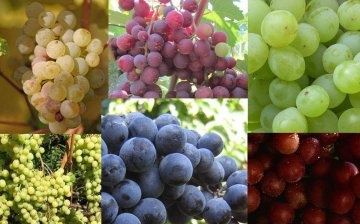
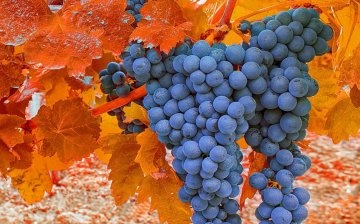
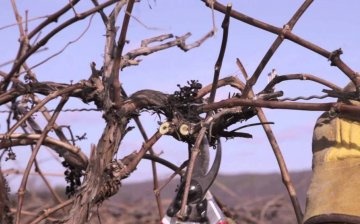
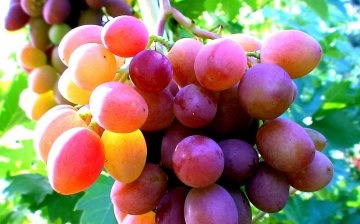
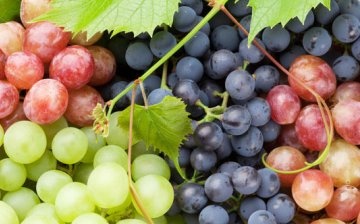





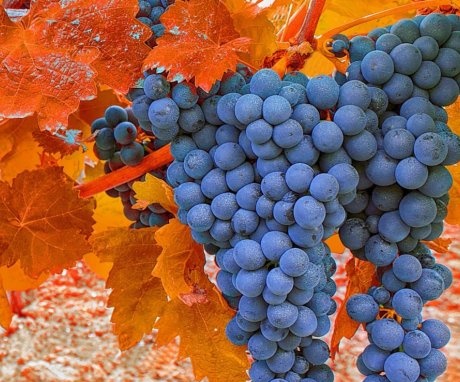
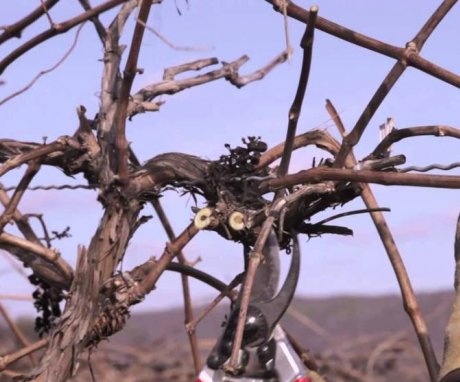
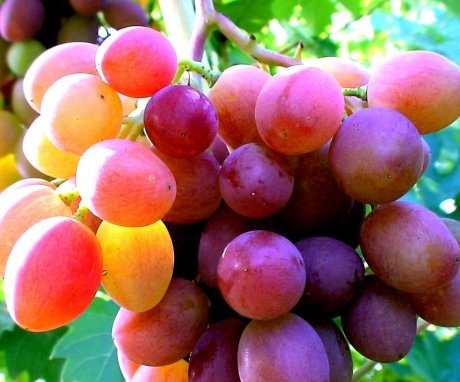
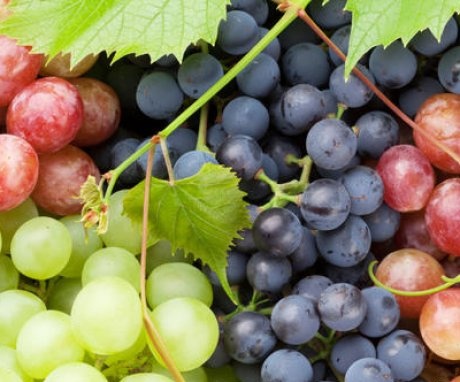
We grow the Rogachev variety on our site. Delicious variety. There were no problems with frost resistance. Last year, the bush got a little sick, the leaves and berries began to turn white and mold. I had to cut to the maximum. On the advice of friends, he processed the remaining overgrowths with a light solution of potassium permanganate. So far everything is fine, we managed to get rid of an incomprehensible disease.
We bought the "Riddle of Sharov" grape variety, which is perfectly zoned for Northern Ukraine, central Russia and Siberia. The variety is resistant to cold in summer and severe frost in winter.
We grow the Adalmina grape variety, which is remarkably adapted for Ukraine. It is frost-hardy and early ripening and is a wine grape that makes the perfect wine.
The most popular grape varieties in our region are Isabella and Lydia. These varieties braid gazebos, terraces, and some gardeners let them along the wall of the house from the south side, or even on the balconies of apartment buildings. In summer, the grapes create a good shade, and when you step out onto the balcony at the end of August, you can pick a delicious bunch of grapes.